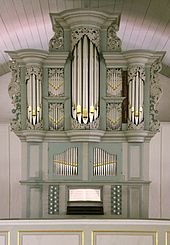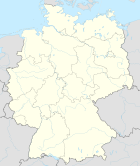Grasberg
| coat of arms | Germany map | |
|---|---|---|

|
Coordinates: 53 ° 11 ′ N , 8 ° 59 ′ E |
|
| Basic data | ||
| State : | Lower Saxony | |
| County : | Osterholz | |
| Height : | 5 m above sea level NHN | |
| Area : | 55.55 km 2 | |
| Residents: | 7783 (Dec. 31, 2019) | |
| Population density : | 140 inhabitants per km 2 | |
| Postal code : | 28879 | |
| Area code : | 04208 | |
| License plate : | OHZ | |
| Community key : | 03 3 56 002 | |
| LOCODE : | DE GBG | |
| Community structure: | 17 districts | |
| Address of the municipal administration: |
Speckmannstrasse 30 28879 Grasberg |
|
| Website : | ||
| Mayoress : | Marion Schorfmann ( CDU ) | |
| Location of the community of Grasberg in the district of Osterholz | ||
Grasberg ( Low German Grasbarg ) is a municipality in the district of Osterholz in Lower Saxony . It is located about 20 kilometers northeast of Bremen in the adjacent moor .
geography
Community structure
The municipality consists of the following districts (the year of foundation in brackets):
- Woerpedorf (1751)
- Eickedorf (1753)
- Rautendorf (1762)
- Schmalenbeck (1762)
- Dannenberg (1780)
- Tüschendorf (1782)
- Meinershausen (1785)
- Grasdorf (1784)
- Huxfeld (1789)
- Seehausen (1790)
- Middle Moor (1792)
- Otterstein (1794)
- Adolphsdorf (1800)
- Weinkaufsmoor (1826)
- Grasberg (Kernort) (1831)
history
Until around 1750, the area of today's Grasberg community was an impassable and completely uninhabited bog . Only the green spaces on both river banks of the Wörpe were used for agriculture by the Tarmstedt and Wilstedt farmers.
Then Jürgen Christian Findorff was commissioned by the Elector of Hanover with the drainage and settlement. He founded numerous villages, initially Wörpedorf (1751) and Eickedorf (1753).
The Grasberg was originally a sand hill ( 5 m above sea level ) that was visible from afar and because of its fresh green , which was apparently dry enough that grass could grow there. This area was probably called “Grasberg” even before the settlement.
|
From 1785 onwards, a church was built on the initiative of Findorff . On Sunday, November 1st, 1789, the state superintendent Johann Hinrich Pratje held the church consecration. On this occasion, 4,000 believers came, whom the church could not hold by far.
Officially, the village of Grasberg has only existed since January 1, 1831, although a small settlement had arisen here as early as 1776, but which was initially regarded as Eickedorfer Vorweide .
Population numbers and incorporations
In 1910 all fifteen present-day districts of Grasberg were still independent villages, Grasberg was the second smallest. In the 1920s, four of them were incorporated into larger neighboring communities due to their small population. The population figures for 1910 and 1939 are listed in the table on the right.
Wörpedorf, Grasberg and Eickedorf grew together with increasing settlement. Already before 1974 there was a merger under the name Grasberg.
On March 1, 1974, the communities of Adolphsdorf, Dannenberg, Huxfeld, Otterstein, Rautendorf, Schmalenbeck, Seehausen and Tüschendorf and parts of the area of the dissolved community of Heidberg were incorporated. On July 1, 1976, a part of the municipality Wilstedt with at that time a little less than 50 inhabitants (Wilstedter Moor) was added. Parts of the neighboring municipality of Tarmstedt (Tarmstedter Moor) followed in 1983.
politics
Municipal council
The council of the Grasberg parish consists of 20 councilors. This is the specified number for a municipality with a population of 7,001 to 8,000. The 20 council members are elected by local elections for five years each. The current term of office began on November 1, 2016 and ends on October 31, 2021.
The full-time mayor Marion Schorfmann (CDU) is also entitled to vote in the council of the municipality.
The local election on September 11, 2016 resulted in the following result:
| CDU | 13 seats |
| SPD | 4 seats |
| GREEN | 3 seats |
mayor
The full-time mayor of the Grasberg community has been Marion Schorfmann (CDU) since 2006. In the last mayoral election in 2014, she was re-elected unopposed with 90.8% of the vote.
coat of arms
Blazon : "In silver on a green curved shield base , covered with a silver corrugated strip, a red church with a tower in front with red windows, open gate and shingled pointed roof, decorated with a golden cross, accompanied on both sides by an outwardly inclined green oak leaf."
The coat of arms refers in all symbols to the 1968 merged community Grasberg. The green mountain (shield foot) and the red church (Grasberg church) symbolize Grasberg, the wavy strip stands for the Wörpe von Wörpedorf and the oak leaves for Eickedorf.
Community partnerships
-
 Szamocin , municipality in Poland
Szamocin , municipality in Poland
-
 Suså ( Suså Kommune ), municipality in Denmark , partnership ended because Suså was dissolved as part of a local government reform.
Suså ( Suså Kommune ), municipality in Denmark , partnership ended because Suså was dissolved as part of a local government reform.

Culture and sights
Findorff-Hof Museum
The Findorff-Hof is a rural farm complex, as it was typical in the moor villages of the region in the 19th century. The main house as the center of the courtyard is set up as a museum and serves the Findorff-Heimatverein Grasberg e. V. as a place of activity.
Grasberg Church
The Evangelical Lutheran Grasberg Church was built in 1781–1789 by Jürgen Christian Findorff. It holds a special feature originally in 1694 for a hamburger orphanage built Baroque - the organ of Arp Schnitger . In its shape it is the only preserved small city organ by this famous organ builder .
Village parade in July
In the third week of July is held annually, on the occasion of the shooter festival in the district Huxfeld, village parade instead. This parade started for the first time, according to the motto of the Love Parade of 1998 with one car and 30 visitors. The organizers are the Schmalenbeck village youth and the Huxfeld shooting club. In 2014 there were 20 cars and around 2500 visitors.
Economy and Infrastructure
economy
Grasberg is part of the Northwest European Metropolitan Region . Of the 1106 employees, 34% come from the areas of trade, hospitality and transport, 32% manufacturing, 27% services, and 6% agriculture and forestry. Grasberg has 662 in-commuters and 2,300 out-commuters; mainly from and to Bremen. (All figures from 2010)
The place has the industrial areas Huxfeld-Nord and Wörpedorfer Ring
Regionally and nationally known companies from Grasberg include:
- the food manufacturer Zeisner Feinkost GmbH & Co. KG (spicy sauces, especially tomato ketchup)
- Photovoltaic wholesalers and photovoltaic assembly system manufacturer SEN Solare Energie Nord Vertriebsgesellschaft mbH
- Michaelis Maschinenbau GmbH
- Cordes bark mulch
The former Wörpedörfer mill was situated at the entrance Mills -, feed - and land trade business , which repeatedly advanced operating system from silos and mill buildings shaped the townscape since the 1930s until it was demolished in 2011 and formed a landmark of Grasberg. The company, run by several generations of the Gieschen family, was created in 1904 from an old mill building and in 1925 received its own siding of the small railway Bremen – Tarmstedt . In 1936, the first grain silo was built with what was then the "enormous capacity" of 400 tons. In 1962 a large grain drying plant was added while fine flour production was given up. In 1973 the company joined the Hansa-Landhandel-Lahde network. In 1999 a major fire destroyed large parts of the mill complex in Grasberg. After the company's activities were relocated to branches in Mulmshorn and Wilstedt and a new plant was built in the Bremen grain port, the Wörpedörfer mill was given up and demolished in 2011.
Public transport
The VBN regional bus line 630 connects Grasberg with Bremen and Zeven. In night traffic before Sundays and public holidays, the line runs every hour as N63 with a connection to and from line 4 of the Bremen tram in Falkenberg .
The citizens' bus 612 and 616 has been serving the western towns and parts of Worpswede since November 15, 2010 . A bus is used that runs every two hours from Monday to Friday during the day.
The small railway Bremen – Tarmstedt ("Jan-Reiners-Bahn") was in operation from 1900 to 1956 and had the three train stations Wörpedorf-Grasberg, Eickedorf and Tüschendorf in what is now the municipality.
literature
- Karl Lilienthal: Jürgen Christian Findorff's legacy . Melloh, Lilienthal 1982. Reprint of the 3rd edition from 1931.
- Rolf Metzing, Johann Schriefer, Fritz Westphal: Grasberg . Saade, Osterholz-Scharmbeck 1987, ISBN 3-922642-17-9 .
- Schwietering, Volkhard: Consecrated to the Creator - History and Stories of the Grasberg Church 1789–1989 . Saade, Osterholz-Scharmbeck 1989.
- The municipalities of the region: An aspiring place on the edge of the Teufelsmoor , in: Weser-Kurier , June 24, 2010
Web links
- Grasberg , official website
- Adolphsdorf , district of Grasberg, village community
- Huxfeld-Mittelmoor , district of Grasberg, village community
Individual evidence
- ↑ State Office for Statistics Lower Saxony, LSN-Online regional database, Table 12411: Update of the population, as of December 31, 2019 ( help ).
- ↑ a b c Grasberg: In the footsteps of the moor colonizer Jürgen Christian Findorff Landschaftsverband Stade, accessed on December 16, 2016
- ^ Jürgen Udolph (research): The "place name researcher". In: website NDR 1 Lower Saxony . Archived from the original on December 2, 2016 ; accessed on August 4, 2019 .
- ↑ About the consecration of the parish in Grasberg 225 years ago
- ↑ From Moordorf to modern commune
- ^ Community encyclopedia for the Free State of Prussia: Province of Hanover Verlag des Prussian State Statistical Office, 1930
- ↑ http://www.gemeindeververzeichnis.de/gem1900/gem1900.htm?hannover/osterholz.htm
- ↑ Michael Rademacher: German administrative history from the unification of the empire in 1871 to the reunification in 1990. Osterholz.html. (Online material for the dissertation, Osnabrück 2006).
- ^ Federal Statistical Office (ed.): Historical municipality directory for the Federal Republic of Germany. Name, border and key number changes in municipalities, counties and administrative districts from May 27, 1970 to December 31, 1982 . W. Kohlhammer, Stuttgart / Mainz 1983, ISBN 3-17-003263-1 , p. 243 f .
- ↑ Municipal election on September 11, 2016
- ^ Lower Saxony Municipal Constitutional Law (NKomVG) in the version of December 17, 2010; Section 46 - Number of MPs , accessed on November 21, 2014
- ↑ A woman with fast leadership Osterholzer Kreisblatt February 4, 2012
- ↑ Individual results of the direct elections on May 25, 2014 in Lower Saxony ( Memento of the original from March 3, 2016 in the Internet Archive ) Info: The archive link was inserted automatically and has not yet been checked. Please check the original and archive link according to the instructions and then remove this notice. , accessed November 14, 2014
- ^ The Findorff-Hof on the website of the Grasberg community
- ↑ Dorfparade 2014 Schützenverein Huxfeld, accessed on December 19, 2016
- ↑ Heinrich bending: The Wörpedörfer mill. In: Heimat-Rundblick . History, culture, nature. No. 106, 3/2013 ( autumn 2013 ). Druckerpresse-Verlag , ISSN 2191-4257 , p. 13.
- ↑ Line timetables for the Bremen / Lower Saxony transport association
- ^ Citizen bus Grasberg-Worpswede




